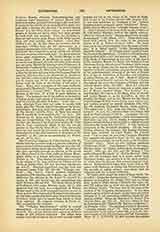

Litany of the Holy Name, an old and popular form of prayer in honor of the Name of Jesus. The author is not known. Probably Binterim (Denkwurdigkeiten, IV, I, 597) is correct in ascribing it to the celebrated preachers of the Holy Name, Saints Bernardine of Siena and John Capistran, at the beginning of the fifteenth century. At the request of the Carmelites, Pope Sixtus V (1585-90) granted an indulgence of 300 days for its recitation (Samson, “Die Allerheiligen Litanei”, Paderborn, 1894, 14). Though this was an implied recognition of the litany, requests made in 1640,1642, and 1662, for formal approval were rejected. In 1862 Pius IX approved one of the formularies in use, and attached an indulgence of 300 days for the faithful of the dioceses whose bishops had made special application. Leo XIII (January 16, 1886) extended the privilege to the entire world (Beringer, “Die Ablasse”, Paderborn, 1900, 142).
This litany is arranged on the plan of the Litany of Loreto, and begins with the invocation of the Holy Trinity. The first part enumerates a list of praises referring to Jesus as God and as man. Remembering the blessing bestowed on Peter’s confession (Matth., xvi, 16), we call Jesus, “Son of the Living God“, “Splendor of the Father” and “Brightness of Eternal Light” (the true light, which enlighteneth every man that cometh into this world—John, i, 9). He is the “King of Glory” (Ps. xxiii, 10), the “Sun of Justice, rising for them that fear the name of the Lord” (Mal., iv, 2). But, lest this splendor and glory make us fear, we turn to Jesus in His humanity, and appeal to him as “Son of the Virgin Mary”, and, as such, “amiable” and “admirable”; and, though annihilating Himself in taking the form of a servant (Phil., ii, 7), He is still the “mighty God“, “Father of the world to come”, “Angel of the great counsel” (Is., ix, 6). Again, though “most powerful”, he has become for us “most patient” (led as a sheep to the slaughter—Acts, viii, 32), “most obedient” (even to the death of the cross—Phil., ii, 8), “meek and humble of heart” (Matth., xi, 29). He is the “Lover of chastity” and “Lover of us”, blessing the clean of heart (Matth., v, 8), and proving His love for us by giving His life to procure that peace which the angels announced (Luke, ii, 14) and life everlasting, whence He is “God of peace” and “Author of life”. During His sojourn on earth He was, and is today, “Model of virtues” and “zealous for souls”, “our God” and “our refuge”; He is “Father of the poor” and “Treasure of the faithful”, the “Good Shepherd” Who lays down His life for His sheep (John, x, 11); He is the “True Light”, “Eternal Wisdom”, “Infinite Goodness”, “our Way and our Life” (Jin, xiv, 6); He is the “Joy of Angels” and “King of Patriarchs”. Through Him all have obtained the knowledge and strength to accomplish God‘s designs, for He is “Master of Apostles“, “Teacher of Evangelists”: “Strength of Martyrs”, “Light of Confessors”, “Purity of Virgins”, and “Crown of all Saints”. After again calling for mercy and the granting of our prayers, we, in the second part of the litany, beg Jesus to deliver us from all evil that would keep us from the attainment of our last end, from sin and the wrath of God, the snares of the devil and the spirit of uncleanness; from eternal death and the neglect of His inspirations. We adjure Him by the mystery of His holy Incarnation, His nativity and infancy, His most Divine life and labors, His agony and Passion His Cross and dereliction, His languor, His Death and burial, His Resurrection and Ascension, His joys and Glory. (Where sanctioned by the bishop, the invocation “Through Thine institution of the most holy Eucharist” maybe added alter “Through Thine Ascension“—S. R. C., February 8, 1905). The litany closes with the triple invocation of the Lamb of God, the petition, “Jesus hear us”, “Jesus graciously hear us”, and two prayers.
FRANCIS MERSHMAN

